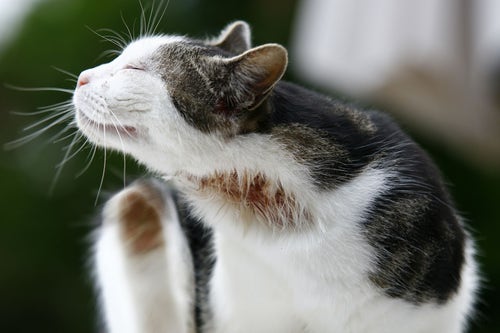Skin allergies in cats are a common yet often challenging issue for pet owners. Characterized by symptoms like itching, redness, and hair loss, skin allergies can significantly affect a cat’s quality of life. Understanding the role of diet in managing these allergies is crucial for providing relief and comfort to your feline friend.
Understanding Skin Allergies in Cats
- Common Allergens and Symptoms: Cats can develop allergies to various substances, including certain foods, environmental allergens, or flea bites. Common symptoms include excessive scratching, red or inflamed skin, and hair loss.
- Diagnosing Skin Allergies: Veterinarians typically diagnose skin allergies through a combination of clinical signs, medical history, and elimination diets. Skin or blood tests may also be conducted to identify specific allergens.
Dietary Management of Skin Allergies
- Hypoallergenic Diets: These diets are formulated to minimize the risk of allergic reactions. They often use hydrolyzed proteins, where the protein molecules are broken down into smaller sizes, making them less likely to trigger an immune response.
- Novel Protein Sources: Introducing a novel protein source that the cat has not previously been exposed to can help identify and eliminate allergens. Options include venison, duck, or rabbit.
- Omega-3 and Omega-6 Fatty Acids: These fatty acids are known for their anti-inflammatory properties and can help soothe irritated skin and improve coat health.
Top Cat Food Brands for Skin Allergies
- Royal Canin Veterinary Diet Hydrolyzed Protein Adult HP: Specifically designed for cats with food sensitivities and allergies.
- Pros: Uses hydrolyzed proteins to minimize allergen exposure.
- Cons: Requires a veterinary prescription and is relatively expensive.
- Price: Approximately $50 for a 7.7-lb bag.
- Availability: Veterinary clinics and specialized online retailers.
- Hill’s Prescription Diet d/d Skin/Food Sensitivities: Offers a limited ingredient formula with novel protein options.
- Pros: Designed to support skin and coat health.
- Cons: Prescription-required, limited flavor options.
- Price: Around $60 for an 8.5-lb bag.
- Availability: Veterinary clinics and select pet stores.
- Blue Buffalo Natural Veterinary Diet HF Hydrolyzed for Food Intolerance: Made with hydrolyzed salmon for cats with food intolerances.
- Pros: Grain-free formula with added vitamins and minerals.
- Cons: Prescription required, higher price point.
- Price: About $40 for a 7-lb bag.
- Availability: Veterinary clinics and select retailers.
- Purina Pro Plan Veterinary Diets HA Hydrolyzed: Formulated to reduce allergic reactions in cats.
- Pros: Highly digestible and hydrolyzed protein source.
- Cons: Prescription required, contains corn starch as a primary ingredient.
- Price: Around $45 for a 4-lb bag.
- Availability: Veterinary clinics and specialized pet stores.
- Natural Balance L.I.D. Limited Ingredient Diets Green Pea & Duck Formula: A non-prescription option focusing on limited ingredients.
- Pros: Made with a single animal protein source, suitable for cats with sensitivities.
- Cons: Some cats may not find limited ingredient diets palatable.
- Price: Approximately $30 for a 10-lb bag.
- Availability: Widely available in pet stores and online.
Feeding Strategies for Cats with Skin Allergies
- Transitioning to a Hypoallergenic Diet: Change diets gradually over 7-10 days to avoid gastrointestinal upset. Start with mixing small amounts of the new food with the current one and gradually increase the proportion.
- Meal Frequency and Portion Size: Feed small, regular meals to ease digestion and reduce potential allergic reactions.
Additional Tips for Supporting Skin Health
- Supplements and Additives: Supplements like fish oil, rich in omega-3 fatty acids, can be beneficial. Always consult a vet before adding supplements to your cat’s diet.
- Environmental and Lifestyle Factors: Regular grooming, maintaining a clean environment, and using hypoallergenic bedding can also help reduce allergen exposure.
FAQs About Cat Food for Skin Allergies
- How long does it take to see improvement in my cat’s skin condition after changing the diet? Improvement can vary, but most cats show signs of relief within 4-6 weeks of starting a hypoallergenic diet.
- Can skin allergies be completely cured with diet? While diet plays a crucial role in managing allergies, it may not be a complete cure. Environmental factors and other allergens may still affect your cat.
- What should I do if my cat refuses to eat hypoallergenic food? Try different hypoallergenic brands or flavors. Sometimes, mixing a bit of wet food with dry kibble can make it more appealing.
- Are there any side effects of hypoallergenic cat foods? Generally, hypoallergenic diets are safe and well-tolerated. However, any dietary change can cause temporary digestive issues like diarrhea or constipation.
- How can I tell if my cat’s food is causing skin allergies? An elimination diet, where you feed your cat a simple diet and gradually reintroduce foods, can help identify specific allergens.
Conclusion
Choosing the right cat food is vital for managing skin allergies in cats. A diet tailored to minimize allergen exposure and support skin health can significantly improve your cat’s comfort and quality of life. Regular veterinary check-ups and careful monitoring of your cat’s diet and environment are key in successfully managing skin allergies.

Jane Doe, a veterinarian with over 10 years of experience, combines her deep knowledge of animal health with a passion for pet welfare at PetsPonder.com. With a DVM degree and a commitment to the latest in veterinary science, Jane Doe offers reliable, compassionate advice to help pet owners make informed decisions for their furry companions.

Leave a Reply